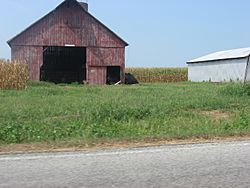Hovey Lake-Klein Archeological Site facts for kids

Caborn-Welborn culture and some of its larger sites. Hovey Lake is in the center of the red area
|
|
| Location | Posey County, Indiana, United States |
|---|---|
| Region | Posey County, Indiana |
| Coordinates | 37°49′49.37″N 87°57′13.43″W / 37.8303806°N 87.9537306°W |
| History | |
| Founded | 1400 |
| Abandoned | 1650 |
| Cultures | Caborn-Welborn variant of the Mississippian culture |
| Site notes | |
|
Indiana Register of Historic Sites
|
|
The Hovey Lake-Klein Archeological Site (12 PO 10) is an important place where archaeologists study the past. It was once a large village of the Caborn-Welborn culture, which was a part of the larger Mississippian culture. This ancient village was located on the west side of Hovey Lake in Posey County, Indiana. This lake is a quiet "backwater" area near where the Ohio River meets the Wabash River. People lived here for many years, from about 1400 to 1650 CE.
Exploring the Hovey Lake-Klein Site
The Hovey Lake-Klein Archeological Site is found on a raised area of land, called a terrace. It is about 3.6 kilometers (about 2.2 miles) from the Ohio River, right next to Hovey Lake in Indiana. The entire site covers a large area, roughly 11.8 hectares (about 29 acres).
What Was the Village Like?
The village was carefully planned. It had a central open space, known as a plaza, where people likely gathered for events. Around the entire village, there was a strong fence called a palisade. This palisade was built with towers, called bastions, which helped protect the village.
Homes and Daily Life
The houses at Hovey Lake-Klein were typical for the Mississippian culture. They were rectangular and built using a method called wattle and daub. This means walls were made from woven branches (wattle) covered with a mix of mud, clay, and straw (daub). These homes were set into shallow dug-out areas. Many houses had special fireplaces made of clay for cooking and warmth.
Near most of the houses, archaeologists found special pits. These pits were used to store important foods like maize (corn) and other dried foods. These storage pits were quite large. They could hold enough grain to feed about 7 to 12 people for an entire year! This shows how important farming was to the people living at Hovey Lake-Klein.



